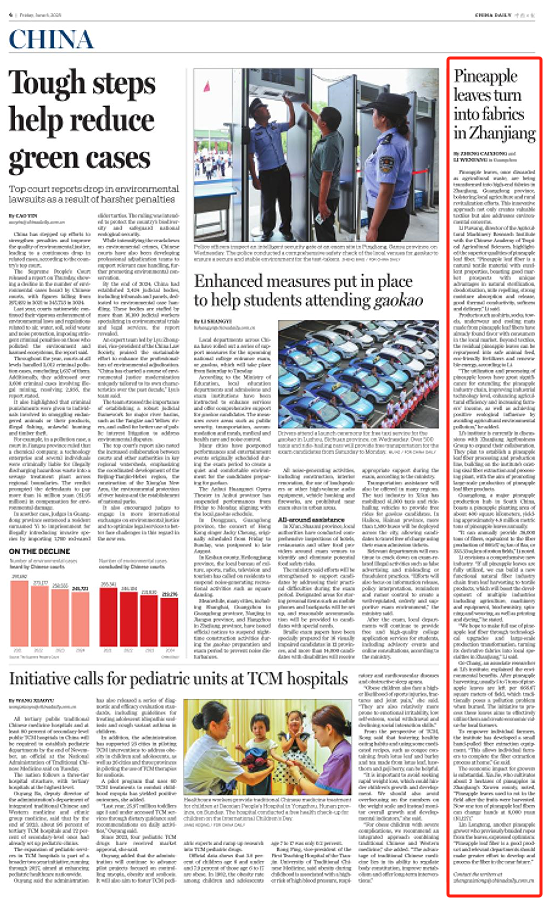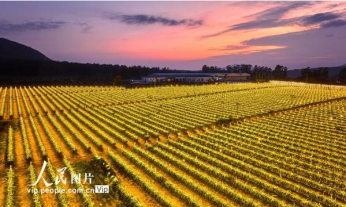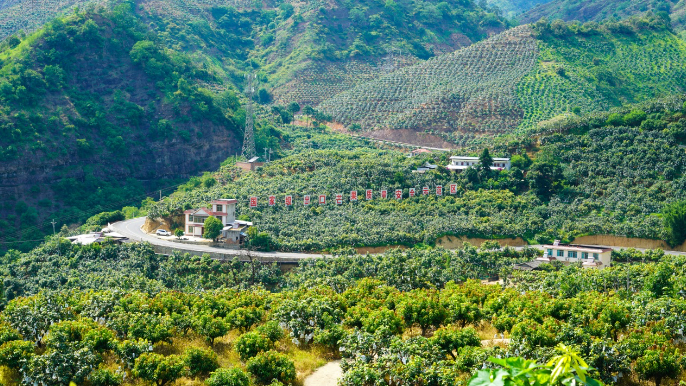
《China Daily》 2025-06/06/ Page004
Pineapple leaves, once discarded as agricultural waste, are being transformed into high-end fabrics in Zhanjiang, Guangdong province, bolstering local agriculture and rural revitalization efforts. This innovative approach not only creates valuable textiles but also addresses environmental concerns.
Li Puwang, director of the Agricultural Machinery Research Institute with the Chinese Academy of Tropical Agricultural Sciences, highlighted the superior qualities of pineapple leaf fiber. "Pineapple leaf fiber is a natural textile material with excellent properties, boasting good market prospects with unique advantages in natural sterilization, deodorization, mite repelling, strong moisture absorption and release, good thermal conductivity, softness and delicacy," Li said.
Products such as shirts, socks, towels, underwear and cooling mats made from pineapple leaf fibers have already found favor with consumers in the local market. Beyond textiles, the residual pineapple leaves can be repurposed into safe animal feed, eco-friendly fertilizers and renewable energy, according to Li.
"The utilization and processing of pineapple leaves have great significance for extending the pineapple industry chain, improving industrial technology level, enhancing agricultural efficiency and increasing farmers' income, as well as achieving positive ecological influence by avoiding agricultural environmental pollution," he added.
Li's institute is currently in discussions with Zhanjiang Agribusiness Group to expand their collaboration. They plan to establish a pineapple leaf fiber processing and production line, building on the institute's existing sisal fiber extraction and processing plant, with the aim of promoting large-scale production of pineapple leaf fiber products.
Guangdong, a major pineapple production hub in South China, boasts a pineapple planting area of about 400 square kilometers, yielding approximately 4.8 million metric tons of pineapple leaves annually.
"It can annually provide 36,000 tons of fibers, equivalent to the fiber production of 666.67 sq km of flax, or 333.33 sq km of cotton fields," Li noted.
Li envisions a comprehensive new industry. "If all pineapple leaves are fully utilized, we can build a new functional natural fiber industry chain from leaf harvesting to textile products, which will boost the development of multiple industries including agriculture, machinery and equipment, biochemistry, spinning and weaving, as well as printing and dyeing," he stated.
"We hope to make full use of pineapple leaf fiber through technological upgrades and large-scale production transformation, turning its derivative fabrics into local specialties in Zhanjiang," Li said.
Ge Chang, an associate researcher at Li's institute, explained the environmental benefits. After pineapple harvesting, usually 5 to 7 tons of pineapple leaves are left per 666.67 square meters of field, which traditionally poses a pollution problem when burned. The initiative to process these leaves aims to effectively utilize them and create economic value for local farmers.
To empower individual farmers, the institute has developed a small hand-pulled fiber extraction equipment. "This allows individual farmers to complete the fiber extraction process at home," Ge said.
The economic impact for growers is substantial. Xia Jie, who cultivates about 3 hectares of pineapples in Zhanjiang's Xuwen county, noted, "Pineapple leaves used to rot in the field after the fruits were harvested. Now one ton of pineapple leaf fibers can change hands at 8,000 yuan ($1,127)."
Lin Longteng, another pineapple grower who previously braided ropes from the leaves, expressed optimism: "Pineapple leaf fiber is a good product and relevant departments should make greater effort to develop and process the fiber in the near future."
News report Link:https://www.chinadaily.com.cn/a/202506/06/WS68424127a310a04af22c37c6.html








 琼ICP备11000394号
琼ICP备11000394号 琼公网安备 46010602000325号
琼公网安备 46010602000325号